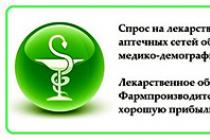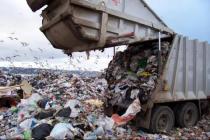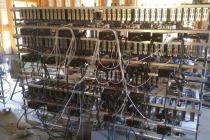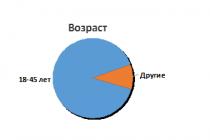Work is the most important quality characteristic of any production process. The quality of the products produced and the demand for them depend on the quality of labor. This is especially important when the firm is non-price competitive.
Work force is defined as a specific product that directly serves as the primary source of production of goods and services, since it contributes to best organization conducting business activities. The number of labor force is determined by such concepts as employment and unemployment, and it is they that characterize the economic situation in the country.
Work force- these are people involved in production, on the one hand, and the totality of human abilities, on the other. The quality of the commodity "labor" shows the degree of efficiency of the market economy, how competitive it is in this respect. On the one hand, the labor force is a quantitative characteristic of the labor potential of a firm or enterprise, that is, the number of people of a certain age and level of education and qualifications. On the other hand, the labor force is represented by a complex of all the abilities and skills of the worker, which he uses to carry out his activities. It turns out that in order to belong to a certain field or type of activity, a person must at least have experience, professionalism and certain theoretical knowledge.
The labor force is an element of the labor market, where it becomes an object of demand from entrepreneurs, firms, the state wishing to hire additional workers, and the supply that comes from households, individuals, intermediary firms and other economic entities. Labor exchange, problem solving employment and employment, is one of the varieties of the labor market. It contributes to a more rational and efficient distribution of the labor force across sectors of the economy, since it does this solely on the basis of the labor characteristics of the workers themselves.
The following conditions for the emergence of the commodity "labor power" can be distinguished:
1) an employee or any economically active entity must have legal freedom, the right to dispose of their knowledge, skills and abilities, as well as to use the available opportunities;
2) the subject of labor must himself be deprived of those products, means of labor or factors that he can obtain as a result of the sale of his own labor.
The labor force has the following qualities:
1. An employee carrying out labor efforts + knowledge, experience, qualifications, education = income. In other words, the labor force, together with the owner of labor, is an indivisible whole and, as a result, brings him factor income as wages.
2. If the work of an employee is not realized for a long time, then its effectiveness decreases over time. Employment ability is the skill of conducting any activity. Over time, theoretical principles can be forgotten, education also loses its power, and experience disappears. In order for these characteristics not to be lost, but to be multiplied, the employee must regularly use them, including replenishing knowledge through practical achievements.
Thus, in any country, an important problem is to increase the employment of labor resources. To this end, the state, as the highest authority, invests, subsidizes and encourages labor activity.
The labor market: its features and main types
Labor market is a system economic relations, which arises on a contractual basis between an entrepreneur who wants to increase the staff of employees, and an employee who is looking for a job and is ready to start it. The main elements of the labor market are the age-old economic categories of supply and demand for a product called "labor power". In addition, this includes both the type of competition itself and the cost of remuneration for a unit of labor (salary + bonuses and allowances), which are formed on the basis of qualification category worker. When a person is looking for a job, he turns to the labor market for information. Through this, he finds out which vacancies and specialties need to be replenished, what is the salary for performing a certain job, correlates the received data with his own capabilities and desires, and makes his choice.
Accordingly, the labor force is an object of the labor market, which can be characterized as follows:
1) the person himself is not an object of sale, as it was in the era of slavery. The individual and his freedom are legally protected, therefore only what a person can offer the employer is subject to sale, namely: diligence, efficiency, experience, qualifications, creative potential etc. In addition, the employment transaction is carried out exclusively on a voluntary contractual basis so that both parties are satisfied;
2) the working abilities of a person cannot be separated from him, therefore they are the main source of income or wages. For a certain amount of work performed in accordance with the terms of the contract, the employee receives a salary, salary. If the labor activity had high quality characteristics or results, there is a bonus system in the form of additional earnings-reward, which further stimulates the individual to achieve the goal;
3) simple labor or its non-use for any time inevitably leads to the loss of useful characteristics. For example, an employee who has higher education, a sufficiently high qualification and work experience, but who has not worked in his specialty for a long time, loses his professional skill and his qualitative characteristics. Therefore, when he returns to his former work, he begins to adapt in a new way to its conditions and requirements.
Demand in the labor market is presented by those organizations, firms, the state, and sometimes the “foreign” sector that need to replenish the staff of employees and are ready to hire a certain number of workers for a certain fee. The supply is provided by the fact that individuals, intermediary firms, households are willing to sell their labor skills and receive for this, in their opinion, a fair amount of money. It is not necessary that demand always coincides with supply, but if such a situation arises, an equilibrium sets in, that is, a situation where the desire of employers to attract new employees to the activity is fully compensated by the need of people to find a job. As a result, the equilibrium nominal wage is formed. However, for the workers themselves, it is precisely its real value that is most important, since prices are extremely dynamic and the cost consumer basket changes regularly.
The dependence of labor demand on the minimum wage can be expressed feedback, i.e. the more the nominal wage grows, the smaller the number of workers the entrepreneur decides to provide workplace. The law of diminishing marginal productivity works. In other words, the greater the amount of labor involved in production or another type of activity, the less becomes the utility or productivity of each additional unit of labor involved. For the organization, the most rational solution is the issue of the number and structure of employees, in accordance with which its expansion will be carried out until the result of the activity of a single employee fully meets the needs of the company.
The supply curve on the market is presented differently, there is an inverse relationship between the amount of labor and its payment. Initially, a substitution effect occurs, i.e., as the wage rate rises, the number of people who want to find a job and use their labor abilities grows, since the majority of workers are still motivated by high earnings. However, at a certain level of income, the demand for labor begins to decline because firms cannot afford to increase fixed costs. Labor ceases to be a priority and is replaced by leisure, therefore, there is an income effect.
Thus, we can distinguish the following factors that qualitatively affect the size and structure of the proposal.
1. Total population of this territorial unit to some extent reflects the structure of the economically active labor force, namely: employment and unemployment. The higher this indicator, the higher the likelihood that the proposal will be large and differentiated by direction and type of activity.
2. Share of working-age population is directly a determining indicator in calculating the total volume of labor resources that can fully or maximally satisfy the needs of employers.
3. Working hours and working conditions influence the selection of the employee. He automatically tries to find a place where all the necessary conditions would be created for him.
4. Labor mobility determined by the fact that the labor force can move freely within the labor market. Mobility also implies the luring of personnel from one organization to another with the provision of working conditions and its remuneration, which is determined general concept"staff drain".
The labor market is a necessary part of a market economy and, in the broad sense of the word, an aggregate market that describes the magnitude of aggregate demand (organizations or the state that decides to hire additional employees) and aggregate supply (who want to find a job and immediately start it).
If we consider the market in a narrower concept in a static state, then it is a place for making current transactions between employers and, in accordance with the number of this moment vacancies. The current labor market can be divided into two parts, or two types.
open market characterized by the fact that the proposal covers those economic entities that themselves or through intermediaries are looking for work, i.e., need retraining or reorientation. Demand in this case is represented by all vacancies and vacancies.
Hidden labor market in addition to open economic entities, it also includes those employees who are currently engaged in production, economic or other activities, but at any time can be relieved of their duties without prejudice to the organization. In other words, in the future these are potential unemployed people who will subsequently be included in the lists of the open market.
It is important to note that each individual country, in accordance with its national, economic and technological features creates its own labor market.
There are countries that are oriented both to domestic and foreign market labor, i.e. they practice attracting foreigners to the activities who have a sphere of economic interests in the country. At the same time, today it is typical for Russia that highly qualified specialists prefer to move to a country with a more developed market economy to participate in the production of its GDP(gross domestic product) on more favorable working conditions and wages. That's why important task of the labor market at any level (international, federal, regional or local) is the creation of attractive jobs so that there is not only a demand for labor, but that it is satisfied by the desire of economic entities to carry out one or another type of labor activity.
the ability to work, the totality of physical and intellectual abilities that a person has and which are used by him in the production of life's goods. Labor power really exists in the personality of the worker and is the main productive force society, the primary (along with land, nature) factor of wealth, the determining element of the productive forces. Labor force statistics in developed countries usually include all employed (including military personnel) and unemployed. A synonym for the concept is the category "economically active population". In the changes taking place in branch structure labor force, in recent decades, two major trends can be traced: a sharp decline in the number of people employed in agriculture and a significant increase in the service sector. The evolution of the professional and qualification composition of the labor force is also noticeable. The predominant category was predominantly mental workers, the so-called "white-collar workers". Number of employees physical labor shrinks both absolutely and relatively. Among the main areas of state regulation of the labor force are: 1) programs to stimulate employment growth and increase the number of jobs in the public sector; 2) programs for training and retraining of personnel; 3) programs to promote the recruitment of labor; 4) programs for social insurance unemployment.
WORK FORCE
strength, ability to work, the totality of physical and intellectual abilities that a person has and which are used by him to produce life's goods. R. s. can function only in a system of certain production relations and is the main productive force of society, the determining element of the productive forces. “The first productive force of all mankind,” V. I. Lenin emphasized, “is the worker, the laborer” (Poln. sobr. soch., 5th ed., vol. 38, p. 359).
Inactive in the process of labor activity on the substance of nature, modifying and subordinating it to himself, a person, in turn, improves labor skills, gains production experience, and accumulates theoretical and technical knowledge. Decisive influence on character and volume labor functions provides the level of development of the means of labor. Socio-economic conditions for the use of R. s. are directly dependent on the method of combining labor power with the means of production. “That special character and the way in which this connection is carried out,” K. Marx pointed out, “distinguishes various economic eras of the social system” (K. Marx and F. Engels, Soch., 2nd ed., vol. 24, p. 43- 44). Under the conditions of the slave-owning and feudal modes of production, the property (full and incomplete) of the ruling classes in the R. with. was a prerequisite for exploitation based on non-economic methods of forced labor. Under capitalism, R. s. acts as a commodity. R. s. becomes a commodity in the presence of certain socio-economic conditions. First, R.'s carrier with. must be a legally independent person and be able to freely dispose of his R. s. Secondly, the owner R. s. must be deprived of the means of production, i.e., not have the opportunity to conduct an independent economy. R.'s transformation with. into a commodity was a natural result of the development of small-scale commodity production. On the basis of the operation of the law of value (see the Law of Value), a process of differentiation of commodity producers took place. An important role in preparing the conditions for capitalist production, in separating the direct producers from the means of production, was played by such non-economic and economic factors as the expropriation of land, cruel laws against the expropriated, the colonial system, state loans, taxes, protectionism, etc.
Like any other product, R. s. under capitalism it has value and use value. The cost of a specific product R. s. is determined by the cost of the means of subsistence necessary for the worker to carry out normal labor activities and support his family. Along with meeting the needs for food, clothing, housing, the cost of R. s. includes a spiritual element (cultural needs of workers, spending on education, vocational training). Great influence on the size and cost structure of R. s. in different countries have historical features of its formation. R.'s cost with. varies depending on the level of economic development of the country, natural and climatic conditions, revolutionary traditions and organization of the working class.
Contradictory impact on the dynamics of the cost of R. s. rendered by the modern scientific and technological revolution. On the one hand, the gigantic development of the productive forces and the growth of the social productivity of labor lead to a reduction in the cost of the means of subsistence consumed by the workers and, consequently, contribute to a reduction in the value of the specific commodity of labor productivity. On the other hand, there are factors contributing to the increase in the cost of R. s. Yes, intensification production processes requires additional costs associated with compensation for the increased expenditure of physical and nervous energy.
The transformation of science into a direct productive force and qualitative changes in the material and technical base (automation of production, the introduction of cybernetic and calculating devices, chemicalization of production, and so on) led to shifts in the professional and qualification composition of the R. s. in the direction of expanding the number of professions in which mental work predominates, and also predetermined the increase specific gravity workers of high and medium qualification. It also requires additional spending on raising the educational level of the working class, vocational training and retraining of personnel.
In a capitalist society, the cost of R. with. takes the transformed form of wages. The capitalist mode of production is characterized by a tendency for wages to lag behind the value of wages. (See in Art. Living wage). Under the conditions of state-monopoly capitalism, this tendency is intensified under the influence of the policy of prices, taxation, and inflation.
The use value of R. s. consists in the ability of the worker to create surplus value for the capitalist in the process of production. The economic interest of the capitalist as a buyer of R. s. is realized in the fact that in the process of labor activity the value created by the R. s. turns out to be greater than the value of the R. s. Modern capitalism is characterized by the intensification of the exploitation of hired labor.
In a socialist society, R.'s connection with. with the means of production is carried out under conditions of public ownership of the means of production (see Socialist property), on the basis of a planned organization of the production process. According to its economic content, according to the nature of its inclusion in the system of social production, R. s. under socialism is not a commodity. At the same time, under socialism, the form of hiring labor is retained. The acquisition of vital goods necessary to meet the growing needs of members of socialist society and ensure the all-round development of the individual is mediated by cash payments and rewards in accordance with the quantity and quality of labor expended by the worker (with the exception of part public funds consumption). The preservation of the form of hiring labor is due to the presence of a certain economic independence of state and cooperative enterprises, the need to control the measure of labor and the measure of consumption of workers of different qualifications, and the preservation of commodity-money relations in the socialist economy. Socialist society routinely takes into account the cost of life's blessings in the reproduction of R. s. The magnitude of the cost of these vital goods serves as a factor in the formation of the minimum wage under socialism.
In the conditions of a developed socialist society, under the influence of scientific and technological revolution Progressive changes are being made in the professional training and qualifications of workers, the cultural and technical level of the working people is rising, work is becoming increasingly creative, and the differences between manual and mental workers are being erased.
Lit .: Marx K., Capital, vol. 1, ch. 4, 5, 17-24, Marx K. and Engels F., Soch., 2nd ed., vol. 23; Lenin V.I., Speech at the 1st All-Russian Congress on Out-of-School Education, Poln. sobr. soch., 5th ed., vol. 38; his own. Economy and politics in the era of the dictatorship of the proletariat, ibid., vol. 39; The modern working class of the capitalist countries. (Changes in the structure), M., 1965; Gauzner N. D., Scientific and technical progress and the working class of the USA, M., 1968; Social problems modern scientific and technological revolution, M., 1969; Socio-economic problems of the use of labor, M., 1973.
A. A. Khandruev.
Big soviet encyclopedia, TSB. 2012
See also interpretations, synonyms, meanings of the word and what is WORK FORCE in Russian in dictionaries, encyclopedias and reference books:
- WORK FORCE in Vasiliev's Dictionary of Economic Terms:
- the total number of citizens of the country of working age who have a job, and citizens who cannot find work for themselves ... - WORK FORCE
..1) in the statistics of most countries, the economically active population includes the employed and the unemployed; ..2) a person’s ability to work, i.e., the totality of his ... - WORK FORCE in the Thesaurus of Russian business vocabulary:
Syn: workers, ... - WORK FORCE in the Russian Thesaurus:
Syn: workers, ... - WORK FORCE in the dictionary of Synonyms of the Russian language:
Syn: workers, ... - WORK FORCE in the Modern Explanatory Dictionary, TSB:
,..1) in the statistics of most countries, the economically active population includes the employed and the unemployed; ..2) a person’s ability to work, i.e., the totality of his ... - FORCE in the Directory of Miracles, Unusual Phenomena, UFOs, and More:
physical quantity, which is a measure of the impact on any body from the outside or from the inside. In physics, there are mechanical force, the force of sound, inertia, gravity, ... - POWER in Wiki Quote:
Data: 2007-12-26 Time: 14:35:20 * Endurance is more noble than strength. (John Ruskin) * There is power in motion... - WORKING The Illustrated Encyclopedia of Weapons:
PART - a part of a throwing weapon, which is used to strike, thrust and ... - FORCE in the Dictionary of thieves' jargon:
- excellence, ... - FORCE in Miller's Dream Book, dream book and interpretation of dreams:
To dream that someone is using force against you means that you will be defeated by your opponents. If you use force ... - FORCE
GROWTH - the relative increase in the accumulated amount in an infinitely small interval ... - FORCE in the Dictionary of Economic Terms:
Irresistible - see Irresistible FORCE... - WORKING in the Dictionary of Economic Terms:
POWER - 1) in Marxist political economy: a person's ability to work, his labor opportunities. In modern economic science, it is more often used ... - WORKING in the Dictionary of Economic Terms:
WEEK - the norm of working hours in a calendar week. In accordance with Art. 46 of the Labor Code of the Russian Federation, a five-day period is established for employees ... - WORKING in the Dictionary of Economic Terms:
CARD - see OPERATING CARD ... - FORCE in the Concise Church Slavonic Dictionary:
- power, ... - FORCE in the Bible Encyclopedia of Nicephorus:
(Acts 15:40; abbreviated word Silouan 2 Cor 1:19) - one of the 70 apostles, called in the book. Acts to those in charge among brothers (15:22) ... - FORCE in the Big Encyclopedic Dictionary:
(Silos) (1st century) apostle from the 70s, associate and fellow prisoner of the apostle Paul (Acts of the Apostles 15:22, 40-41; 16:19-29), bishop in Corinth. Memory … - FORCE in the Encyclopedic Dictionary of Brockhaus and Euphron:
inertia (in mechanics) - equal and directly opposite to the lost force The lost force is the geometric difference between a given force applied ... - FORCE in the Modern Encyclopedic Dictionary:
- FORCE in the Encyclopedic Dictionary:
(in mechanics), a measure of action on a given material body from other bodies or physical fields. Causes a change in the speed of the body (see ... - FORCE in the Encyclopedic Dictionary:
, -s, w. 1. A quantity that is a measure of the mechanical interaction of bodies, causing their acceleration or deformation; characteristic of the intensity of physical processes (special). … - FORCE
GRAVITY FORCE, force P, acting on any material point located near the earth's surface, and defined as a geom. amount of power... - FORCE in the Big Russian Encyclopedic Dictionary:
CURRENT POWER, equal to electric. charge passing through the cross section of the conductor in 1 ... - FORCE in the Big Russian Encyclopedic Dictionary:
POWER OF LIGHT, the luminous flux propagating inside a solid angle equal to 1 steradian. The SI unit of measure is the candela... - FORCE in the Big Russian Encyclopedic Dictionary:
FORCE OF INERTIA, a vector quantity numerically equal to the product of the mass m of a material point and the modulus of its acceleration w and directed oppositely ... - FORCE in the Big Russian Encyclopedic Dictionary:
THE POWER OF SOUND, the same as the intensity of the wave... - FORCE in the Big Russian Encyclopedic Dictionary:
STRENGTH (in mechanics), a measure of mechanical. actions on a given material body by other bodies. This action causes a change in the velocities of the points... - WORKING in the Big Russian Encyclopedic Dictionary:
WORKING MIXTURE, a mixture of combustible gas or fuel vapor with air in a ratio that ensures its combustion in the engine cylinder, vnutr. combustion. … - WORKING in the Big Russian Encyclopedic Dictionary:
WORK FORCE, in modern. economy science - economically active population, includes employed and unemployed; in Marxist theory - the ability ... - WORKING in the Big Russian Encyclopedic Dictionary:
"WORKING PARTY OF THE POLITICAL LIBERATION OF RUSSIA", populist-SR org-tion, 1899-1902, Minsk; organizers - G.A. Gershuni, L.M. Klyachko. Up to 40 work circles (approx. … - WORKING in the Big Russian Encyclopedic Dictionary:
WORKING PARTY, French. labor party; headed by J. Guesde and P. Lafargue. The decision to create it was made in 1879 (on ... - WORKING in the Big Russian Encyclopedic Dictionary:
Labor Party of Great Britain, see Labor Party ... - WORKING in the Big Russian Encyclopedic Dictionary:
"WORKERS' OPPOSITION", a group in the RCP (b), which arose in 1921 during the trade union discussion (A.G. Shlyapnikov, A.M. Kollontai, S.P. Medvedev and ... - WORKING in the Big Russian Encyclopedic Dictionary:
WORKING WEEK, the statutory duration of work during a calendar week. By growing up right normal duration R.n. cannot exceed 40 ... - WORKING in the Big Russian Encyclopedic Dictionary:
"WORKING THOUGHT", newspaper, organ of "economists", Oct. 1897 - Dec. 1902, 16 issues: St. Petersburg - No. 1-2, Berlin - No. 3-11, ... - WORKING in the Big Russian Encyclopedic Dictionary:
WORKING AREA, a section of the workplace, limited by viewing angles, the amplitude of a person’s movement and his choice of posture in the process of work. Dimensions R.z. … - FORCE in Collier's Dictionary:
physical action that leads or tends to lead to a change in the state of rest or movement material body. The action of any force on the body obeys ...
As a result of the evolutionary development of ideas about a person as a subject of economic life in scientific and educational literature
a number of concepts arose: "labor force", "human resources", "labor resources", "human factor", "labor potential", " human capital". Often similar in content, these concepts carry their own semantic load and reflect the gradual awareness by society of the growing role of man in economic and social life (Fig. 2.1).
Rice. 2.1.
concept "work force" in socio-economic literature and in practical life used in two ways. Firstly, as a set of physical, spiritual and intellectual abilities of a person, which he can use to produce material and spiritual goods, services, i.e. for the implementation of labor activity. Secondly, as a set of carriers of the ability to work - those people who have the indicated abilities. We can say that the labor force as the ability to work is identified with the bearers of this ability - people.
It should be noted that in its second meaning, the concept of "labor force" is used quite widely and its boundaries are not sufficiently defined. Official statistics refer to the labor force as the economically active population, i.e. those people who already actually work or offer themselves in the labor market as potential employees.
If production wealth and services are considered from the standpoint of the resource approach, then the obvious conclusion will be that, along with material, energy, financial resources the most important factor in economic development are human resources, those. people with their professional knowledge and skills. The peculiarity of human resources lies in the fact that they are both the resources of the economy and people - consumers of material goods and services.
As one of the forms of expression of human resources are workforce, which includes able-bodied population working age and actually working teenagers and pensioners. The concept of "labor resources" was born and established in Soviet Russia and other countries of the former Council for Mutual Economic Assistance (CMEA), which practiced central planning as the main method of state influence on the economy. Under these conditions, a person acted as a passive object of external management, as a planning and accounting unit of labor resources. At the same time, as practice has shown, the concept of “labor resources” fits well into the system of modern market categories and, due to its wide information content, can be used as an effective tool for state regulation of the labor market.
The concept of "labor resources" gives a quantitative description of the part of the population that has the ability to work. But it does not take into account the differences in labor abilities and capabilities of people. Therefore, in scientific circulation since the early 1980s. concept was introduced "employment potential" which in the most general form can be defined as labor resources in a qualitative dimension, i.e. taking into account gender, age, education, state of health, consciousness and activity, which determine the "return" of labor resources as a resource of the economy. The concept of labor potential is based on the idea of a person not as a passive object of external management, but as a subject with his own capabilities, needs and interests in the world of work.
From the end of the 20th century theory and practice of management, the view of man as the main, decisive factor in production and social development has become widespread. The priority was the understanding that, in the end, it is not the technical level of production that determines the economic potential of enterprises, organizations, society as a whole, but human factor, embodying the ability to create, invent, produce new knowledge. It is seen as a manifestation of the totality personal qualities a person that affects his work activity. The human factor of production is characterized not only by indicators of the number, demographic, sectoral, professional and qualification structures of workers, but also by indicators of attitude to work, initiative, enterprise, interests, needs, values, ways of behaving in various situations.
The human factor is an economic and political term, the subject of interest of modern general theory systems, labor psychology, ergonomics and sociology. Attention to it is directly related to the need for socio-economic development, which cannot be achieved using authoritarian, administrative-bureaucratic methods of management. The activation of the human factor is a multifaceted problem, which includes complex processes formation moral values, problems of the family, school and home education, the physical health of society, the preservation of cultural traditions, personnel and social policy, education, etc.
Another concept that has gained currency in Lately, is "human capital". It is based on the idea of a person as an object of effective investments and a subject that transforms these investments into a body of knowledge and skills for the purpose of their subsequent implementation. Human capital represents a stock of knowledge, skills and motivations formed as a result of investments, reflecting the totality of the physical, intellectual and psychological qualities and abilities of the individual. It includes innate ability and talent, as well as education and acquired professional qualification. At the same time, investments in human capital are understood as the costs necessary to increase labor productivity in the future, as well as leading to an increase in the qualifications and abilities of a person and subsequently affecting an increase in the income of an individual. It is assumed that a person, making such an investment, sacrifices something less in currently to get something more in the future.
The most striking example of investment in human capital is the cost of education.
An individual's cost of investing in education and training can include three components:
- direct costs (tuition fees, expenses for the purchase of textbooks, change of residence and travel, etc.);
- missed opportunities (lost earnings) during the study and in connection with the probable change of profession, place of work;
- moral damage caused by nervous tension in connection with education, job search, likely change of living environment.
The expected return on investment in human capital can act both in monetary form (individual income growth, enterprise profit growth, the economic growth region), and in non-monetary (getting satisfaction from the chosen work during life, expanding the circle of communication during study, positive information about the organization, a higher assessment of non-market activities and interests).
To effectively invest in human capital, it is necessary to measure and evaluate investment in a person, which is the most problematic and controversial topic in the field of management. by human resourses. Measurements of human capital and evaluation of investment in it are usually imprecise, but the process of measurement itself is extremely important.
As a rule, when evaluating the effectiveness of investments in education costs in the present (C) are compared with the value of future benefits (I). The latter can be calculated by the formula
where В r is the expected excess of the earnings of people who have received an education over the earnings of people who do not have an education, in a year t; P- number of years of use of acquired knowledge; d is the market rate of return on capital (interest rate or discount rate).
Investments in education will pay off (can be considered effective) provided that the present value of future benefits is greater than or at least equal to the costs: R>C.
- As a synonym for this type of resource, some authors use the concepts of "resources for work", "resources of labor", "resources for labor". See: RofeA. I., Zhukov A. L. Theoretical basis economics and sociology of labor. M. : MIK, 1999. S. 116; RofeA. I. Labor Economics. 3rd ed., add. and reworked. M.: KnoRus, 2015.
- See: Labor Economics. Social and labor relations/ ed. N. A. Volgina, Yu. G. Odegova. pp. 44-47.
The concept of "labor" has two essentially different meanings: labor as a process and as an economic resource.
Labor as a process is a type of human activity for the production of goods and resources necessary for consumption in household, or for economic exchange, or both.
Labor is an expedient activity of people aimed at creating material and cultural values. Labor is the basis and an indispensable condition for the life of people. By influencing the natural environment, changing and adapting it to their needs, people not only ensure their existence, but also create conditions for the development and progress of society.
The labor process is a complex and multifaceted phenomenon. The main forms of its manifestation are the expenditure of human energy, the interaction of a worker with the means of production (objects and means of labor) and the production interaction of workers with each other as if horizontally (the ratio of participation in a single labor process), and vertically (relationships between managers and subordinates). The role of labor in the development of man and society lies in the fact that in the process of labor not only material and spiritual values \u200b\u200bare created to meet the needs of people, but also the workers themselves develop, who acquire skills, reveal their abilities, replenish and enrich knowledge. The creative nature of labor finds its expression in the emergence of new ideas, progressive technologies, more advanced and highly productive tools of labor, new types of products, materials, energy, which, in turn, lead to the development of needs.
Thus, in the process of labor activity, not only goods are produced, services are provided, cultural values etc., but new needs appear with the requirements of their subsequent satisfaction. Labor in this case is shown as a continuous, constantly renewing process.
The content of labor is such a generalizing characteristic of the labor process, which takes into account the variety of labor functions, the types of labor operations performed, the distribution production activities by industry, the physical and intellectual stress of the employee in regulating the sequence of labor operations, the possibility and degree of novelty in decisions made during the production process.
The content of labor is determined by its direct technical equipment and depends on the distribution of labor functions in technological process. It plays a decisive role in the implementation of all major social processes in production. Those qualitative changes in social sphere which are planned to be carried out in the process of perestroika are impossible without profound changes in the content of labor. The main role here is called upon to play a technical reconstruction. National economy- mechanization, automation, computerization, robotization, which should have a clear social orientation.
The nature of work indicates the attitude of the worker to various types labor activity. By its nature, labor can be agricultural or industrial, simple or complex, creative or routine, organizational or performing, physical or mental.
The content and nature of labor are closely related. Since they express different aspects of the same ore activity, they are in contact and partially overlap each other. The importance of questions of strengthening the creative content and collectivist character of labor, raising its culture, and tangibly encouraging highly skilled and highly productive work will increase substantially under the conditions of perestroika. All this should help to ensure that labor in production is not only a necessity, but also a vital need for a person. The study of the nature of labor in specific sociological studies begins with a study of the content of labor.
Labor is a purposeful activity of a person who adapts the natural substance of his consumers. The economic side of labor is revealed in the use of labor as a limited resource in combination with other resources or factors of production in order to obtain benefits. From the point of view of sociology, labor acts as a process of socialization. The entry of a person into the team is accompanied by attraction to the established order. In the labor collective, a person becomes an object of observation, control and disciplinary influence. Any individual in the team masters not only professional roles. He, too, learns what it means to be "subordinate" or "boss", "leader" or "outsider", "recognized" or "expelled", "comrade" or "colleague", "leader" or "lagging behind".
In the process of work, the individual learns to respond to pressure from outside, to dose his own efforts, to receive and transmit information, to resolve conflict situations, to establish the necessary connections. Labor is a school of socialization in which a significant part of our life takes place. Here, next to the production of products and services obtained in the process of labor, labor itself acts as the production and reflection of the person himself.
Defining labor, sociologists identify the main public functions, which express its active essence:
- 1. A way to meet human needs.
- 2. Source of social wealth.
- 3. Personal development.
- 4. The driving force of social progress.
- 5. Creator of man throughout the history of mankind.
- 6. Status differentiation.
- 7. “The force that paves the way for a person to will, makes it possible for people to take into account the increasingly distinct natural and social consequences of their actions. It is in labor and with the help of labor that society learns the laws of its development of nature.
The labor force in economic theory is a person's ability to work, the totality of physical and spiritual abilities that a person uses in his activities.
Sometimes the labor force is also understood as the employees of an enterprise, often with the exception of administrative staff.
Karl Marx stated the following in his Capital:
- - Under the conditions of the capitalist mode of production, labor power is a specific commodity. The bearer of the labor force is its owner and is legally free to dispose of it. At the same time, he does not have the means of production for independent management and, in order to obtain a livelihood, he is forced to sell his labor power.
- - The cost of the labor force is determined by the costs of maintaining the life of the worker and the proper level of working capacity, his sufficient training, education and reproduction. These costs significantly depend on the level of economic development of the country, natural and climatic conditions, intensity and complexity of labor, employment of women and children. The cost of labor is manifested in the form of wages, which are additionally influenced by the situation in the economy and the labor market. During a period of economic growth and increased employment, wages can significantly exceed the cost of labor, which allows workers to significantly improve their financial situation. During a recession, wages can fall below the cost of labor, which leads to the expenditure of previously accumulated reserves and to a sharp deterioration in the situation of workers.
- - The value (utility) of labor power as a commodity is the ability in the process of labor (the capitalist's use of the purchased labor power) to create new value, which is usually greater than the value paid to the worker. This excess Marx called surplus value. It is the surplus value that serves as the basis for the formation of profit.
- - Labor power is not always a commodity. It may not belong to a person and be taken without an equivalent exchange (for example, from a slave or a serf). A person may not have legal freedom (a prisoner, a child). A person can work independently and then sell the results of labor, and not his own labor (artisan, artist, farmer, private entrepreneur, if they do not use hired workers).
Part economic theories do not recognize labor power as an independent commodity. They usually claim that labor is sold directly. They explain the formation of profit by the special properties of capital or the payment for the rarity of entrepreneurial talent.
Labor power acts as a commodity in the labor market, it really exists in the personality of the worker. Labor power as a commodity has value and use value. The cost of labor power is the price of material and spiritual goods necessary for the reproduction of labor power, that is, to fully meet the needs of the worker and his family members.
The cost of labor is determined by:
- - cost Money necessary for the reproduction of the life of the worker and his dependents;
- - the level of mechanization of labor productivity in industries producing goods of production and consumption, as well as services;
- - the level of economic development of the country;
- - natural-climatic, cultural and social conditions life of the population;
- - the ratio of supply and demand of labor resources in the labor market.
The measure of the value of labor power, determined by the nature of its connection with the means of production, is determined not only by the use value of labor power, that is, the ability to create added value, but also by the measure of access to the sphere of distribution of this value, determined by the position of the worker in the system of social economic relations.
The main trends that determine the cost of labor are:
- - the growth of labor productivity, reducing the cost of goods and services, and consequently, the cost of labor;
- - scientific and technological progress, which increases the requirements for professional and personal training of an employee;
- - the level of investment in human capital, causing an increase in the cost of labor in the labor market;
- - an increase in the share of the growth of national wealth due to a more skilled workforce.
Let us note the mutually exclusive, contradictory nature of the impact of the noted trends on the dynamics of the value of labor costs, as well as the fact that sometimes the cost of labor includes an assessment of the expected volume of services expected from an employee in an organization, correlated with an assessment of the probability that the employee remains to work in this organization .
The use value of the commodity "labor power" consists in the fact that the worker in the labor process creates a value greater than the value of labor power. And in this capacity, the product "labor" is attractive to the employer, as it allows you to realize his goal - making a profit.














